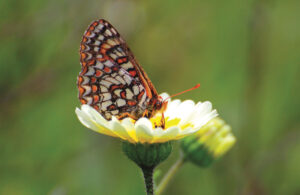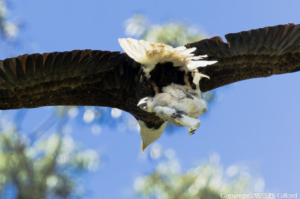If you ask me, there’s nothing to seeing a red-whiskered bulbul (Pycnonotus jocosus) flitting about, living its medium-sized, rosy-cheeked life. But then I grew up in India, where the bird is what a chickadee or turkey vulture is to most Bay Area residents. Ask a birder in San Francisco and a red-whiskered bulbul is an occasion for dropping everything and running – running! – to catch a glimpse. Which is why if you were at Fort Mason around 8 a.m. on April 9, you would have found a bunch of Bay Area bird watchers all aflutter — binoculars up, phones out, asking one another where the bulbul was.
When someone finally found it — a rite of passage shared with many others through those first spring days of the year — they guided other field glasses to the right spot, “move just a little to your left, now do you see that branch kind of jutting out? It’s right there.” Barely seven inches long, the bulbuls have brown coats and white breasts, and as their name suggests, bright red patches just under their eye.
In a lovely illustration of the quotidian becoming extraordinary, many from the milling cluster were here because they had signed up for Ebird’s San Francisco County rare bird alert. For most, the bird was a “lifer” — a first-time sighting. Consider the songbird’s range map and you will know what I mean: dark swathes across most of India, Nepal, Bangladesh, Southern China, Myanmar, Malaysia and Vietnam. In the United States, however, it is found in very small areas marked by pale pixel spots — parts of Florida, Hawaii, and California, which mimic their south Asian homes at the edge of towns and forests.
The bulbul has probably picked Fort Mason because the species doesn’t venture far from areas like gardens and neighbourhoods with exotic tree plantations that are already “disturbed” habitats. They depend on the yearlong supply of fruit and nectar for survival. The community garden is ideal in that sense, as an in-between place that is neither completely tended nor entirely forested, sea nor land, urban nor wild. Bird watchers often spend leisurely hours walking through it, and Ebird lists suggest as many as 180 species can be spotted here on a good day.
About half an hour earlier, as we had entered the garden on a stop in an all-day Birdathon, hundreds of cedar waxwings had burst into flight above us drawing oohs and aahs. The red-masked parakeets had been offered a passing glance before being added to the checklist, and the mockingbirds had been summarily shushed. But the black crest and red undertail coverts of the bulbul invoked such a deep pocket of silence from its onlookers that I knew I was experiencing something remarkable.

The first red-whiskered bulbuls became established in Southern California around 1968 in the Los Angeles County Arboretum and the Huntington Gardens. They were probably escapees — the birds are sought-after in the Asian cage-bird trade. Back in the ‘60s, they were considered non-native pests, a threat to agricultural produce like berries as well as other passerine birds and indigenous arthropods. But planners and researchers have wondered since how much of a threat they really are in California. According to the Centre for Agriculture and Bioscience International’s Invasive Species Compendium, in parts of its introduced range the “evidence of impact is only anecdotal.”
A 1985 Los Angeles Times story reports that officials from the state Department of Food and Agriculture were banned from shooting the birds within the Huntington Gardens while the agency evaluated how dangerous they really were, and many argued that the “bulbuls have not lived up to their menacing reputation and should be allowed to live happily in the confined habitat they chose in 1968.”
I have been wondering for a while now about the labels we put on plants and animals found out of place in what increasingly seems like an out of place world. Only about 10 percent of introduced species in new ecosystems will survive, and only about 10 percent of those will be problematic enough to become “invasive.” Birds that are lost outside their normal range are called vagrants or accidentals, but now scientists sometimes wonder if they aren’t pioneers that could give us hints about future bird distributions as the climate shifts. Our labels tend to change with our understanding of the natural world, and the red-whiskered bulbul is just the latest on this list that I’m learning about.
Back at the garden we are talking about lists too. One of the birders I had come with mentions the common birding concept of a checklist. One-off birds like the bulbul, which don’t have a breeding population in the region, aren’t eligible for checklists. So, my birder friend says, the fact that we are spending so long looking at something that can’t go on our list means that we’ve found something really special. Then when I looked it up later, I found that in 2019, just a year after I moved to the East Bay, The California Bird Records Committee accepted the red-whiskered bulbul to its California list as an introduced (naturalized, non-native) species – and so gave it a place on the list after all. It needed a new family heading, “Pycnonotidae — Bulbuls,” situating it between dippers and kinglets. I think, “Look! It has a place here — it’s in between the dippers and kinglets! It belongs now.”
The Ebird checklist we have created takes note of this too, and says that the bulbul is a “Continuing bird at Fort Mason. Multiple sightings in the East Bay indicate that this species has moved up from Southern California, rather than being an escapee as earlier thought.” I’m not entirely sure why this makes me happy, and I don’t want to make this into an allegory. It’s not. But the happiness remains.
As the climate changes, the ripples it creates have unexpected and far-reaching consequences. These include altered ecosystems, changes in the range and abundance of species, and biodiversity losses and extinctions. Plants and animals continue to move poleward, tracking the climate, in response to rising global temperatures. Any species — whether a climate tracker like the dark unicorn snail, an established non-native that finds conditions favorable to spread farther like the bulbul, or an irredeemable invasive like the zebra mussel — all enter into an ecosystem that is constantly in flux.
Invader. Vagrant. Migrant. Resident. Who knows where one will land, and how long it will take?
For now, I only have questions – but that curve before the certainty of a full stop is not a bad place to make a home. Its uncertainty is a solace all its own. “Be patient toward all that is unsolved in your heart and try to love the questions themselves, like locked rooms and like books that are now written in a very foreign tongue,” as Rilke once famously said. “Live the questions now. Perhaps you will then gradually, without noticing it, live along some distant day into the answer.”





